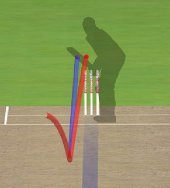
 |
| Index | ||||||
|
Hawk-eye  Named after scientist Dr Paul Hawkins, Hawk-eye has rapidly become an integral part of TV coverage of major Test matches. Developed from missile tracking technology, it tracks the flight of a cricket ball and uses image processing techniques to analyse video images sent from cameras at various positions around the pitch. It can detect the speed of the delivery, where it pitched, and give a good idea of the degree and direction of any swing or deviation From that information it can predict what would have happened to the path of the ball had it not been intercepted - perhaps by the striker's pads. Hawk-eye is an interesting guide for spectators for decisions on dismissals, but there are certain questions that it can't necessarily answer - for example the effect of any changes in the shape or weight of the ball, or in the condition of the pitch that may occur as the match proceeds, or the phenomenon of late swing Hawk-eye unquestionably makes watching a match more interesting and provides the commentators with extra talking points, but it is not intended to replace the on-field umpires. | ||||||